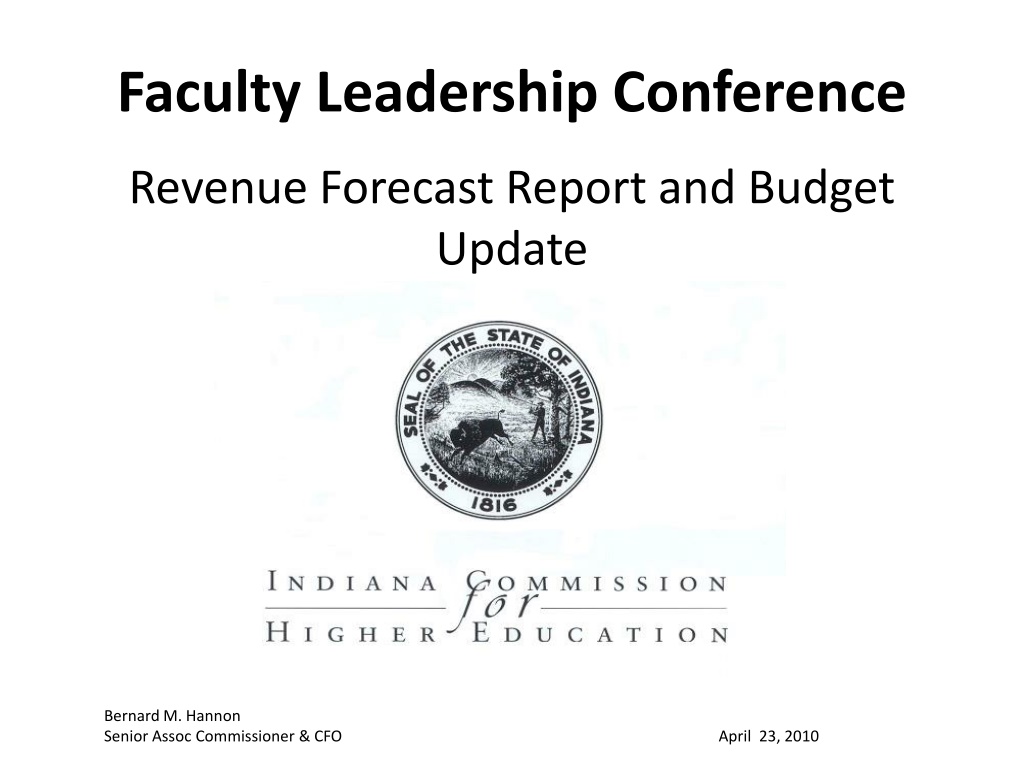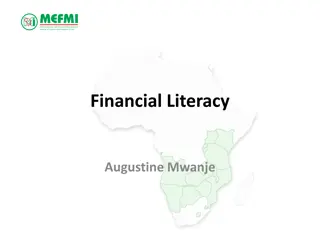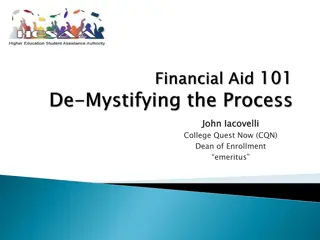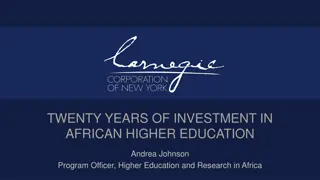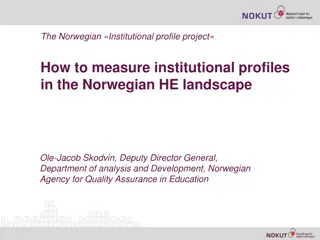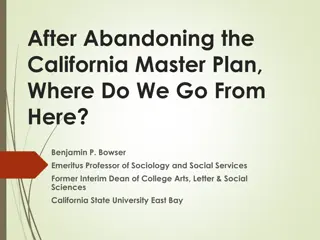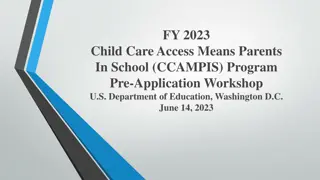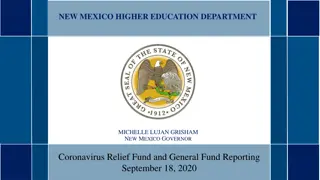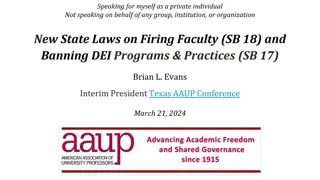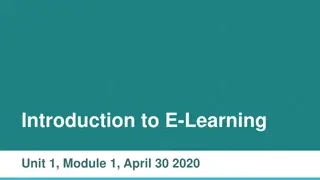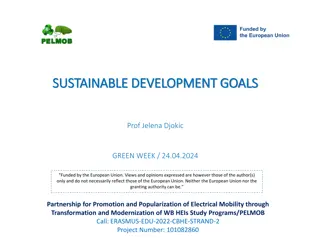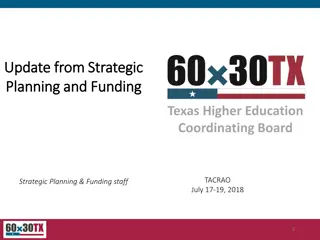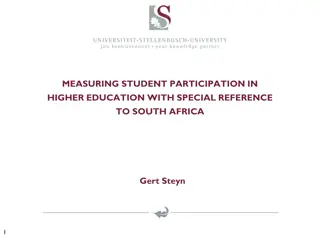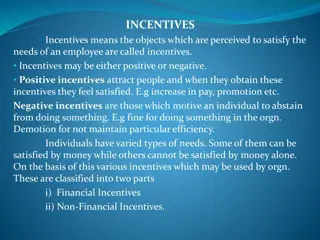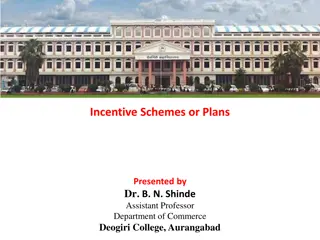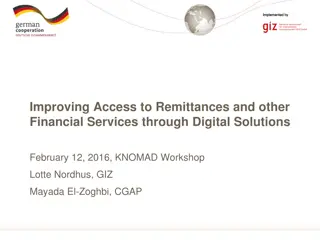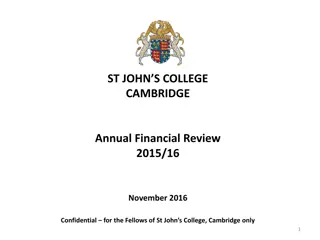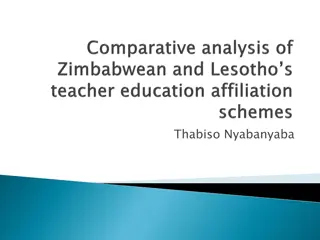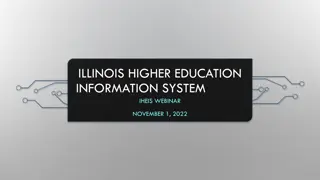Indiana's Higher Education System: Financial Overview
The report provides a detailed analysis of Indiana's public higher education system, including revenue forecasts, budget updates, institutional expenditures, state funding sources and appropriations, and key financial statistics. It highlights the financial landscape of the state's postsecondary institutions, showcasing expenditure estimates, state income and expense breakdowns, and trends in funding allocation over the years.
Download Presentation

Please find below an Image/Link to download the presentation.
The content on the website is provided AS IS for your information and personal use only. It may not be sold, licensed, or shared on other websites without obtaining consent from the author. Download presentation by click this link. If you encounter any issues during the download, it is possible that the publisher has removed the file from their server.
E N D
Presentation Transcript
Faculty Leadership Conference Revenue Forecast Report and Budget Update Bernard M. Hannon Senior Assoc Commissioner & CFO April 23, 2010
INDIANAS HIGHER EDUCATION SYSTEM AND STATE FUNDING
Total FY 10 estimated expenditures by all Indiana public postsecondary institutions $5,090,667,914 Total FY 10 General Fund estimated expenditures by all Indiana public postsecondary institutions $3,487,676,807
Indianas Public Higher Education System 5 four-year Public Postsecondary Institutions 2 two-year Public Institutions 31 Public Campuses and 12 Instructional Sites 407,000 Students in 2008-09 1,500 buildings worth $12B $2.3B in salary and compensation 4
State Operating Appropriations as % of Institutional Expenditures 70.0% % of total exp from state operating appropriations 60.0% % of Operating exp from state operating appropriations 50.0% 40.0% 30.0% 20.0% 10.0% 0.0% Indiana Univ. Purdue Univ. statewide avg. Ball St. Univ. Univ. Southern Indiana Indiana St. Univ. ITCCI Vincennes Univ.
State IncomeBy Source 10% 5% 6% Sales Tax Individual Income Tax 47% Corporate Income Tax Gaming Other 33% Approximately $13 billion per year
State ExpenseBy Source 14% 3% K-12 Higher education 5% Medicaid 48% 5% Teacher Pensions Corrections Child Welfare 13% Other 13% Approximately $13 billion per year
Percentage of state General Fund appropriated to IHEs 25.0% 20.0% 15.0% 10.0% 5.0% 1975-76 1976-77 1977-78 1978-79 1979-80 1980-81 1981-82 1982-83 1983-84 1984-85 1985-86 1986-87 1987-88 1988-89 1989-90 1990-91 1991-92 1992-93 1993-94 1994-95 1995-96 1996-97 1997-98 1998-99 1999-00 2000-01 2001-02 2002-03 2003-04 2004-05 2005-06 2006-07 2008-09 2009-10
State Appropriations to Public IHEs state appropriations 1976 - 2011 $1,400,000,000 $1,200,000,000 $1,000,000,000 $800,000,000 $600,000,000 Compound Annual Growth Rate: 4.7% $400,000,000 $200,000,000 $- 1997-98 1998-99 1999-00 2000-01 2001-02 2002-03 2003-04 2004-05 2005-06 2006-07 2007-08 2008-09 2009-10 2010-11 1975-76 1976-77 1977-78 1978-79 1979-80 1980-81 1981-82 1982-83 1983-84 1984-85 1985-86 1986-87 1987-88 1988-89 1989-90 1990-91 1991-92 1992-93 1993-94 1994-95 1995-96 1996-97
State General Fund Appropriations to Higher Education $2,000,000,000 Total HE Appropriations Campus Operating Appropriations $1,800,000,000 $1,600,000,000 $1,400,000,000 $1,200,000,000 $1,000,000,000 $800,000,000 FY 2000 FY 2001 FY 2002 FY 2003 FY 2004 FY 2005 FY 2006 FY 2007 FY 2008 FY 2009 FY 2010 FY 2011 Total appropriations include: SSACI, capital and line item appropriations
HIGHER EDUCATION STATE FUNDING NATIONAL CONTEXT
FY 2009 State Appropriations per FTE $16,000 $14,000 $12,000 U.S. Avg. $6,934 $10,000 Indiana $4,752 $8,000 $6,000 $4,000 $2,000 $- Wyoming Alaska Hawaii Idaho North Carolina Oklahoma Nevada Georgia New Mexico Connecticut New York Texas Alabama Maryland Louisiana Kentucky Arkansas Tennessee Illinois New Jersey Mississippi Arizona Nebraska US California Maine Florida Wisconsin Washington West Virginia Utah Minnesota Missouri Iowa Virginia South Carolina Delaware Kansas Massachusetts Pennsylvania North Dakota Michigan Oregon Ohio Rhode Island Indiana Montana Colorado South Dakota New Hampshire Vermont
FY 2009 Net Tuition Revenue per FTE $14,000 $12,000 $10,000 Indiana $5,379 $8,000 U.S. Avg. $4,095 $6,000 $4,000 $2,000 $- Vermont Delaware Rhode Island Pennsylvania Michigan New Hampshire Maine New Jersey Maryland West Virginia North Dakota South Carolina Virginia Connecticut Iowa Alabama Indiana South Dakota Ohio Kentucky Colorado Minnesota Arizona Oklahoma Arkansas Montana Massachusetts Oregon Alaska Missouri US Kansas Mississippi Tennessee Texas Wisconsin Nebraska New York Illinois Utah Hawaii Idaho Louisiana Nevada North Carolina Florida Washington Georgia Wyoming New Mexico California
FY 2009 Total Educ. Revenue per FTE $20,000 $18,000 $16,000 U.S. Avg. $10,991 $14,000 Indiana $10,102 $12,000 $10,000 $8,000 $6,000 $4,000 $2,000 $- Wyoming Alaska Delaware New Jersey Maryland Vermont Maine Connecticut Pennsylvania Rhode Island Oklahoma Alabama Kentucky Michigan Hawaii Texas Arkansas West Virginia Idaho North Dakota New York Arizona Tennessee Iowa Mississippi Virginia Illinois Nevada Minnesota North Carolina US Nebraska Georgia South Carolina New Hampshire Louisiana Wisconsin Missouri New Mexico Ohio Massachusetts Indiana Kansas Oregon Utah Colorado Montana Florida Washington South Dakota California
2009 Tax Revenue per Capita $8,000 $7,000 $6,000 U.S. Avg. $4,242 $5,000 Indiana $3,332 $4,000 $3,000 $2,000 $1,000 $- Alaska New York Wyoming Connecticut New Jersey Hawaii Massachusetts Maryland California Vermont Minnesota Rhode Island Illinois Maine Washington Delaware U.S. Pennsylvania Virginia Wisconsin Nevada Kansas North Dakota Nebraska Louisiana Ohio Florida Colorado New Mexico Michigan Arizona Iowa New Hampshire North Carolina Georgia Texas Montana Oregon West Virginia Utah Indiana Oklahoma Missouri Arkansas Kentucky Idaho South Carolina South Dakota Mississippi Tennessee Alabama
2009 Total Taxable Resources per Capita* $90,000 $80,000 $70,000 U.S. Avg. $52,754 Indiana $45,213 $60,000 $50,000 $40,000 $30,000 $20,000 $10,000 $- Delaware Connecticut Wyoming Alaska New Jersey New York Massachusetts Maryland Nevada Virginia California Washington New Hampshire Colorado Illinois Minnesota Rhode Island Hawaii U.S. South Dakota Texas Florida Nebraska Louisiana North Dakota Pennsylvania Kansas Oregon Iowa Vermont Wisconsin North Carolina Georgia Ohio Indiana Missouri Arizona Tennessee Oklahoma Utah New Mexico Montana Maine Michigan Idaho Alabama Kentucky South Carolina Arkansas West Virginia Mississippi *Total Taxable Resources per capita from U.S. Treasury Department: www.treas.gov/offices/economic- policy/resources/estimates.html
Indiana per Capita Income as Percentage of U.S. Average 100.0% 98.0% 96.0% 94.0% 92.0% 90.0% 88.0% 86.0% 84.0% 1969 1970 1971 1972 1973 1974 1975 1976 1977 1978 1979 1980 1981 1982 1983 1984 1985 1986 1987 1988 1989 1990 1991 1992 1993 1994 1995 1996 1997 1998 1999 2000 2001 2002 2003 2004 2005 2006 2007
Higher Education Appropriations per $1,000 of Personal Income $20.00 $18.00 $16.00 $14.00 $12.00 Indiana $6.95 U.S. Avg. $6.80 $10.00 $8.00 $6.00 $4.00 $2.00 $0.00 New Mexico Alabama Mississippi North Carolina Wyoming Hawaii Louisiana Alaska North Dakota West Virginia Arkansas Kentucky Nebraska Utah Georgia South Carolina Oklahoma Idaho Iowa Kansas California Tennessee Minnesota Texas Delaware Indiana United States South Dakota Washington Arizona Florida Wisconsin Maryland Maine Michigan Montana Nevada Ohio Illinois Virginia Oregon Connecticut New York Missouri New Jersey Pennsylvania Rhode Island Massachusetts Vermont Colorado New Hampshire
State Revenue Performance
State General Fund Revenue Growth 15.0% 13.1% 10.0% 7.4% 7.5% 6.9% 6.3% 5.7% 5.4% 4.5% 5.0% 2.9% 2.4% 0.0% -0.8% -3.6% -5.0% -7.4%-6.4% -10.0% 1998 1999 2000 2001 2002 2003 2004 2005 2006 2007 2008 2009 2010 2011 Note: FY 10 and FY 11 per December 2009 Revenue Forecast
Revenue Growth and Higher Education Appropriations 2000-2011 15.0% GF growth HE approps 10.0% 5.0% 0.0% -5.0% -10.0% 2000 2001 2002 2003 2004 2005 2006 2007 2008 2009 2010 2011
State Expenditure Growth 9.7% 10% 9% 8.0% 7.6% 8% 7.1% 6.5% 5.6% CAGR 1996-2005 2.3% CAGR 2006-2009 7% 6% 5.1% 4.9% 5% 4.1% 3.9% 4% 2.8% 2.7% 3% 1.9% 2% 0.8% 0.5% 1% ----- F1996 F1998 F2000 F2002 F2004 F2006 F2008
Real Per Capita Expenditures* $2,400 $2,350 $2,300 CAGR = -1.3% $2,250 $2,200 $2,150 $2,100 FY 2004 FY 2005 FY 2006 FY 2007 FY 2008 FY 2009 * Includes Major Moves Investments
Revenue Collections FY 2006 FY 2011 $14,500 $14,005 $14,000 $13,701 $13,500 $13,135 $12,906 $13,000 $12,836* $12,500 $12,076* $12,000 $11,500 $11,000 FY06 FY07 FY08 FY09 FY10 FY11 *projected
Comparison of Forecasted to Actual Revenue 15% 10% 5% Percent Change (FY2010 vs. FY2009) 0% -5% Targets from May Forecast -10% Targets from December Forecast -15% -20% -25% July August September October November December January February March April May June Year-to-date = -10.5% Last year = -7.4% 25
The Good News is: We Entered the Recession in a Strong Financial Position
Budget Surplus/Deficit 1,000.0 500.0 ----- 1998 1999 2000 2001 2002 2003 2004 2005 2006 2007 2008 2009 (500.0) (1,000.0) (1,500.0)
State Reserves (Cash Liabilities) 1600 1329 1400 1200 1000 800 600 400 200 0 2001 2002 2003 2004 2005 2006 2007 2008 2009 -200 -179.2 -400
The Bad News is: The Challenges are Unprecedented
Much Worse Than Prior Recessions 6.0% 4% 4.0% 1.3% 2.0% 0.0% FY 1991 FY 1992 FY 2001 FY 2002 FY 2009 FY 2010 -2.0% -0.8% -4.0% -3.6% -6.0% -8.0% -7.4% -10.0% -10.5% -12.0%
Sales Tax: CY 2009 vs. CY 2008 0% -4% -4% -4% -5% -9% -9% -9% -10% -10% -11% -15% -20% -25% -25% -30%
Budgeted Revenue: FY 2010-11 29,000 Dec-08 Apr-09 May-09 Dec-09 28,143 28,000 27,452 Current Spend 26,748 27,000 26,000 24,913 25,000 24,000 23,000 Forecast reduced over $3 billion in one year. Missed forecast 17 straight months
Without Budget Management, State Reserves would be Depleted by End of Biennium Total State Reserves in millions $1,500 $1,329 $1,000 $500 $379 $211 $0 6/30/09 3/1/10 6/30/10 6/30/11 ($500) ($909) ($1,000) ($1,500)
Summary Progress, But More Action Needed -$1.8 billion (=December 2009 revenue projection vs. May 2009 budget) +$770 million (= agency and education reductions) +$1 billion (= all remaining reserves and rainy day funds) -$112 million (=revenue loss since December 2009 forecast) = -$142 million deficit if no further actions are taken Goal continue to take necessary actions to spend within our means, align operating expenses with operating revenues and avoid tax increases
State Fiscal Outlook Even if current forecast is met, state reserves balances will be fully expended Next legislative session portends most difficult biennial budget in memory: Loss of federal stimulus funds ($867M SFSF) Revenue and expenditure imbalance No state reserves to draw down
Commission Budget Responsibilities and Priorities Debt Service College Completion Incentives: Number of Degrees On-Time Degrees Low Income Degrees Enrollment/Student Course Success Incentive Research Funding Incentive R&R Economic Development Two-Year Transfer Incentive Student access and success (SSACI) 37
Evolution of CHE Funding Recommendations 2001 2003 2005 2007 2009 Enrollment Change (successfully completed credit hours) Enrollment Change (credit hours enrolled) Enrollment Change (credit hours enrolled) Enrollment Change (credit hours enrolled) Enrollment Change (credit hours enrolled) Inflation Adjustments Inflation Adjustments Inflation Adjustments Inflation Adjustments Equity Adjustment Equity Adjustment Equity Adjustment Equity Adjustment Plant Expansion/leases Plant Expansion/leases Program Adjustment Research Support Incentive Research Support Incentive Research Support Incentive Change in number of degrees Change in On-Time graduation Rate Two Year Transfer Incentive Research Support Incentive Change in number of degrees Change in On-Time graduation Rate Two Year Transfer Incentive Low Income Degree Completion Incentive Workforce Development Incentive (funding non- credit coursework)
